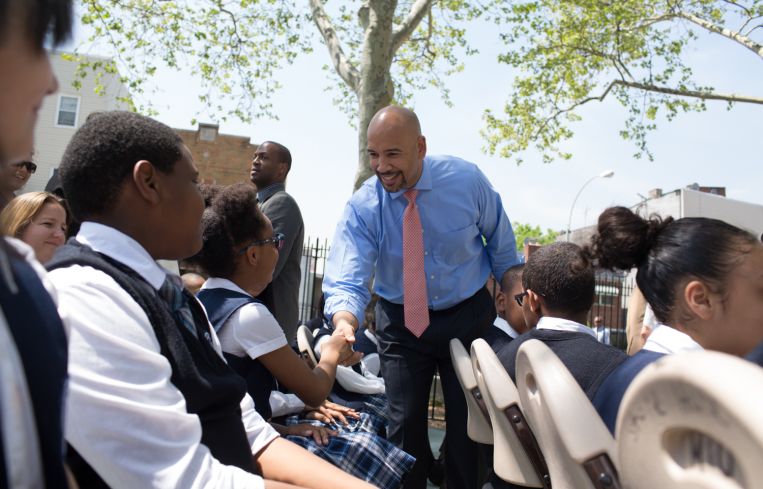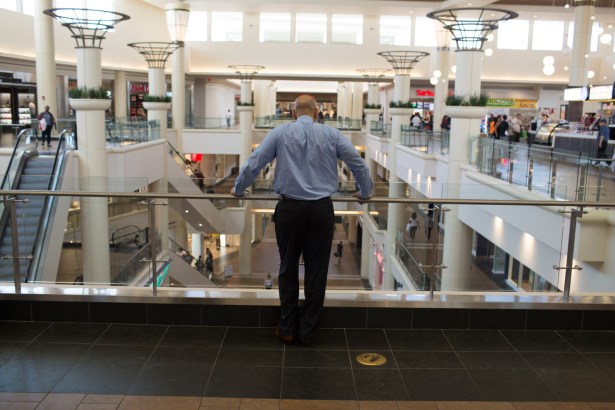Bronx Beep Rubén Díaz Jr. Is in a Hurry to Change the City’s Poorest Borough
By Will Bredderman August 19, 2015 10:30 am
reprints
Some 400 finance and real estate honchos recently filled the Villa Barone Manor in the Throggs Neck neighborhood of the Bronx for the 17th annual “Bankers Breakfast.” While the keynote speaker for the event was William Dudley, the president and chief executive officer of the Federal Reserve Bank of New York, the headliner was really the effusive 42-year-old emcee: Bronx Borough President Rubén Díaz Jr.
“This is our moment!” he boomed. “This is the time now where we show the world, not only do the negative stereotypes of the past for the Bronx not apply any more, but we are progressing and we’re going to show everyone else how it’s done!”
Since Mr. Díaz entered Borough Hall in 2009, the Bronx—for decades a byword for urban decay—has added about 15,000 jobs and almost 17,000 new apartments. Crime is at its lowest level since the 1960s. Mr. Díaz is not shy about asserting where the credit belongs: “In the past, if we were being shortchanged and we were being overlooked here in the Bronx, it was just because our politics weren’t as strong as they should have been.”
Once unimaginable facilities have blossomed in the “new Bronx,” including the $269 Trump Links golf course (that Trump), the 2.2-million-square-foot Bay Plaza retail development with a recently-opened indoor mall (see reason 4 on why the Bronx is awesome starting on page 27) and the sprawling 42-acre Hutchinson Metro Center office complex and its new 125-room Marriot Residence Inn. Mr. Díaz insisted on visiting them all with this reporter.
The politician, a former assemblyman and 2021 mayoral prospect, is similarly unabashed about describing his part in facilitating the projects. Borough presidents are typically viewed as figureheads. But a well-connected “beep” can still be a tremendous ally to developers trying to usher a project through the city’s arcane Uniform Land Use Review Procedure.
The borough president handpicks half the members of the local community board that first reviews a proposed project, submits his own letter of recommendation on the development and has a representative on the City Planning Commission, which subsequently considers the new construction. The City Council has the final say on any zoning change or public land disposition, but it usually defers to the wishes of the local councilman—which is where Mr. Díaz’s power in the Bronx County Democratic machine becomes crucial to a developer.
“If you conduct yourself in a certain way, if [real estate interests] know they can count on you, that you’re a friend—or that, you know, it’s not a good thing to have you against them—then everybody is willing to work—[people are] prepared to work with you,” Mr. Díaz said.
The borough president has cultivated an image as a pro-business Democrat and forged close relationships with Hutchinson Metro Center developer Joseph Simone and Prestige Properties’ Sam Shalem, who owns the Bay Plaza site.
The Marriott Hotel that opened in June, the first of its kind in the borough, was something of a gamble for Mr. Simone.
“We spoke to him. I said, ‘We need a hotel in the Bronx, no more hot sheet hotels anymore,’ “ Mr. Díaz said. “He knew that I wanted it, and he wanted to continue a good relationship with the borough president. And he made the borough president happy.”
The development of Mr. Shalem’s mall required substantial investment in new infrastructure, including $3.4 million from the state Thruway Authority to widen the nearby exit ramp of I-95—and thus the cooperation of Gov. Andrew Cuomo, a close friend of the borough president. Mr. Díaz not only sat on Mr. Cuomo’s 2010 transition team, but co-chaired his re-election campaign.
“Then you start saying, ‘Hey, you ever think of expanding?’ or they come to you and say, ‘We want to have a mall here,’ then you have conversations with State DOT, City DOT—what happens with the lanes out there,” recalled Mr. Díaz. “Joe Simone has other properties, Sam has other properties, they want other opportunities.”
Mr. Díaz insisted that Prestige see to it that Bronxites were hired to build the mall and to work in it once it was complete. To that end, Mr. Cuomo deployed his “Unemployment Strikeforce” to run jobs fairs for the project in cooperation with the borough president’s office. The governor even put out a press release when the mall opened in August, a year ago last Friday.
“This new project is a big win for the Bronx,” Mr. Cuomo announced. “I welcome shoppers from every corner of New York and beyond to visit this new space.”
Mr. Díaz was also a staunch supporter of the Trump Links golf course built atop a former garbage dump in Throggs Neck, which golfing legend Jack Nicklaus designed and which is run by none other than real estate baron Mr. Trump. Mr. Díaz remained a defender even as critics pointed out taxpayers had to put up some $230 million to see it built, foot its nearly $300,000 annual water bill and pay at least $100 per player to use it. Mr. Trump, who shelled out $10.8 million toward constructing the clubhouse, also has the right to close it to the public for special events and tournaments.
‘This is the time now where we show the world, not only do the negative stereotypes of the past for the Bronx not apply any more, but we are progressing and we’re going to show everyone else how it’s done!’—Rubén Díaz Jr.
The borough president was there to tee off on opening day on April 2—and is so well known to managers at the course that one rushed out to ask him if he would be playing his usual round when he toured it with this reporter in May. At the opening of the links to the press, Mr. Díaz was gushing in his praise of Mr. Trump. [Disclosure: Mr. Trump is the father-in-law of CO Publisher Jared Kushner.] This put him in a somewhat awkward position a month later when Mr. Trump declared Mexican immigrants were “rapists” “bringing drugs” into the country in his presidential campaign kickoff speech—causing NBC to drop Mr. Trump from his reality show The Apprentice, and prompting the Puerto Rican-American Mr. Díaz to issue a press release denouncing him.
“NBC’s actions today should send a strong message to Donald Trump that hateful, divisive rhetoric will not be tolerated, and that such rhetoric has real consequences,” Mr. Díaz’s official statement said.
Mr. Díaz was not always known as an ally to development interests.
Shortly after taking office in 2009, he led the bid to stop WE Companies’ effort to convert the hull of the Kingsbridge Armory into a mall, a plan that had the backing of then-Mayor Michael Bloomberg. Mr. Díaz insisted that, as a subsidized project, the mall’s future vendors should be obligated to pay at least $10 an hour to workers (in New York State, the minimum wage is currently $8.75 per hour). Related balked at the proposal, and a public battle ensued, with mall supporters painting the borough president as anti-progress in the press.
“They had all their friends in the media come after me. And now we don’t have a relationship,” Mr. Díaz acknowledged—though he quickly struck a conciliatory note. “I’m open to having one in the future.”
Now, the Armory is slated to become the massive Kingsbridge National Ice Center, with nine rinks and a 5,000-seat arena, developed by ex-Deutsche Bank executive Kevin Parker and to be managed by famed pro-hockey player Mark Messier—a plan the borough president fiercely supported.
Mr. Díaz has also lobbied the state to support and help fund a plan to turn a 96-acre plot of public land along the Port Morris neighborhood into park and recreational space easily accessible to residents—which, combined with a 2005 rezoning of the surrounding industrial area, may lead to a property boom. The state Department of Environmental Conservation last year labeled the project a priority, though it still has several layers of approval to go.
“We’ve already got hipsters in there,” Mr. Díaz said, pointing to a loft building on Bruckner Boulevard near the corner of Lincoln Avenue, just a few hundred feet from the Harlem River.
Just blocks away, Silvercup Studios—the city’s largest TV and film production company—is transforming a warehouse into a 115,000-square-foot complex, its third in the city. The Bronx Overall Economic Development Corporation, a semi-private development not-for-profit where Mr. Díaz sits on the board of directors, lobbied Silvercup for years to consider opening a location in the borough.
“Hollywood played a considerable role in creating the poor perception of the Bronx in the past, and now they can help our revival,” Mr. Díaz said, hoping the new studio will lure in new investment and cultural tourism.
But perhaps the biggest development of Mr. Díaz’s tenure will be $1 billion worth of investment with potential to transform the borough: four new Metro North stations running down its eastern corridor, taking passengers into Manhattan’s Penn Station. Mr. Díaz became infatuated with the idea when he sat on the Assembly’s Transportation Committee before becoming borough president, and shared it with the man who then sat next to him in session—the newly minted Assembly Speaker Carl Heastie.

In 2013, Mr. Díaz and another former Assembly colleague, Bronx State Senator Jeffrey Klein, produced a report arguing that the project would create 5,400 jobs and boost property values by an average of almost $150,000. He pitched Mr. Cuomo on the idea, and the governor allocated the funding in 2015 executive budget.
Walking along the desolate stretch of Basset Avenue—now home mostly to auto body shops—near where one of the stations will be built, Mr. Díaz seemed almost overwhelmed with how the new stop and an accompanying rezoning would transform the corridor.
“Think about what we could have here! We could have market-rate housing. You could have home ownership. We could have mixed-income, commercial development,” he said. “This would be a prime spot here!”
The ultimate goal, Mr. Díaz argued, is to bring the renaissance that has transformed Manhattan, Brooklyn and parts of Queens to the Bronx.
“We’re creating housing for Bronxites, we’re creating jobs,” Mr. Díaz said. “That’s the American Way. It’s the way of New York City. It’s the way of the Bronx. Why shouldn’t we have all the things the other boroughs have? Why shouldn’t we have them here?”


